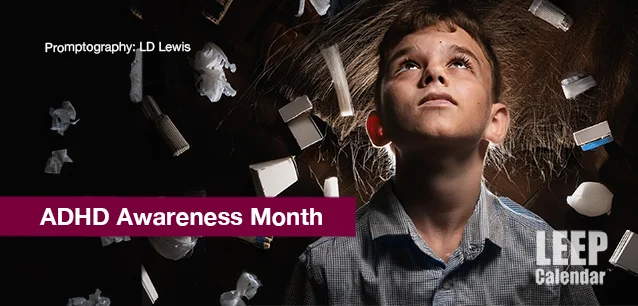 AD
AD
Today is: October 24
Scroll to explore events active on this date.
Additional Events on LEEP
LEEP INK FEATURES

August? Absolutely!
In August, we live through the Dog Days of Summer. It's hot and often humid, and those who can leave for better climates do. Down south, winter is in full force. August is also known as "the ...

In The Heat of July: July 2025 Events
Is it hot enough (or cold enough if you're below the equator) for you yet? There is actually a day for that! Like every month, I pick a diverse collection of events you may or may not know about. This ...

May Blooms: Events in May 2025
Along with October, May is one of the most densely packed months of the year. It's before the summer humidity and the last whole month of the school year. The weather is warming in t...
About ADHD Awareness Month
Finance & Banking , Education
Ends: Oct 31, 2024
DESCRIPTION:
UNDERSTANDING ADHD:
ADHD AWARENESS MONTH
ADHD Awareness Month raises awareness about Attention-Deficit/Hyperactivity Disorder (ADHD), a neurodevelopmental disorder that affects both children and adults. The event aims to educate the public about ADHD, reduce the stigma associated with it, and provide resources and support to individuals living with ADHD and their families.
WHAT IS ADHD
ADHD is a condition characterized by persistent patterns of inattention, hyperactivity, and impulsivity that interfere with functioning or development. It is one of the most common mental disorders in children, though it also affects many adults.
The history of ADHD dates back to the early 20th century. In 1902, Dr. George Still, a British pediatrician, first described a condition resembling ADHD. He described a group of children who were impulsive, inattentive, and had difficulty with self-control, which he attributed to a defect in moral control. This early description laid the groundwork for what would later become known as ADHD.
The term "Attention-Deficit Disorder" (ADD) emerged in the 1980s, and the condition was later renamed ADHD, reflecting the recognition of hyperactivity as a core feature in many individuals. The American Psychiatric Association (APA) officially included ADHD in its Diagnostic and Statistical Manual of Mental Disorders (DSM) in 1980.
Various organizations support this event, including CHADD (Children and Adults with Attention-Deficit/Hyperactivity Disorder), the Attention Deficit Disorder Association (ADDA), and the ADHD Coaches Organization (ACO). These organizations work together to provide education, support, and advocacy for individuals with ADHD, their families, and the professionals who work with them.
WHAT CAUSES ADHD?
The exact cause of Attention-Deficit/Hyperactivity Disorder (ADHD) is not fully understood, but research suggests that it is likely due to a combination of genetic, neurological, and environmental factors. Here's a closer look at what is currently known about the causes of ADHD:
GENETICS
ADHD tends to run in families, indicating a strong genetic component. Studies have shown that if a parent has ADHD, there is a higher chance that their child will also have the disorder. Specific genes related to the neurotransmitter dopamine, which plays a key role in attention and impulse control, have been linked to ADHD.
NEUROLOGICAL FACTORS
—Brain Structure and Function:
Differences in brain structure and activity have been observed in individuals with ADHD. For example, certain areas of the brain, such as the frontal lobe, which is involved in executive functions like decision-making, problem-solving, and impulse control, may be smaller or less active in those with ADHD.
—Neurotransmitter Imbalances:
Neurotransmitters, particularly dopamine and norepinephrine, are chemicals that transmit signals in the brain. Imbalances or deficiencies in these neurotransmitters are believed to play a role in ADHD, affecting attention, motivation, and emotional regulation.
ENVIRONMENTAL FACTORS
Prenatal and Early Childhood Factors:
Exposure to certain environmental risks during pregnancy or early childhood may increase the likelihood of developing ADHD. These include:
Prenatal exposure to alcohol or tobacco:
Smoking or drinking alcohol during pregnancy has been linked to a higher risk of ADHD in children.
Premature birth or low birth weight:
Babies born prematurely or with a low birth weight are at an increased risk of developing ADHD.
Exposure to toxins:
Lead exposure, particularly in young children, has been associated with an increased risk of ADHD.
Psychosocial Factors:
Although not direct causes, psychosocial factors such as family stress, early trauma, or unstable home environments may exacerbate the symptoms of ADHD.
DIET AND LIFESTYLE FACTORS
—Dietary Factors:
While diet alone is not believed to cause ADHD, specific dietary components, such as excessive sugar, artificial food additives, and food allergies, may influence the severity of symptoms in some children. However, this is still a topic of ongoing research and debate.
—Screen Time:
Excessive screen time and lack of physical activity have been suggested as potential factors contributing to attention issues in some children. However, these are not recognized as primary causes of ADHD.
BRAIN INJURIES
In some cases, a Traumatic Brain Injury (TBI) can lead to symptoms that resemble or exacerbate ADHD, though this is not a common cause.
ADHD is likely the result of a complex interplay between genetic predispositions and environmental influences. While a family history of ADHD and specific brain characteristics can predispose an individual to the disorder, environmental factors may trigger or worsen symptoms.
Understanding that ADHD is a multifactorial condition helps in approaching its diagnosis and treatment more holistically, focusing on both medical interventions and supportive environments.
WHAT ARE THE SYMPTOMS OF ADHD?
ADHD symptoms are divided into two categories: inattention and hyperactivity/impulsivity. Individuals with ADHD may exhibit symptoms from one or both categories:
INATTENTION
—Difficulty sustaining attention in tasks or play activities
—Often makes careless mistakes in schoolwork or other activities
—Frequently loses things necessary for tasks and activities
—Easily distracted by extraneous stimuli
—Often forgetful in daily activities
HYPERACTIVITY AND IMPULSIVITY
—Fidgets with hands or feet or squirms in seat
—Unable to stay seated
—Runs about or climbs excessively in inappropriate situations
—Talks excessively
—Interrupts or intrudes on others (e.g., butts into conversations or games)
These symptoms can lead to academic, occupational, and social difficulties.
HOW PREVALENT IS ADHD?
ADHD is one of the most common neurodevelopmental disorders, affecting an estimated 5-10% of children worldwide and about 4-5% of adults. The prevalence of ADHD varies depending on the criteria used for diagnosis and the population being studied. In the United States, it is estimated that around 6.1 million children aged 2-17 have been diagnosed with ADHD, according to data from the Centers for Disease Control and Prevention (CDC).
ADHD Awareness Month plays a crucial role in promoting understanding and acceptance of ADHD. By raising awareness, the event helps to reduce the stigma associated with the disorder, encourages early diagnosis and intervention, and provides essential support for individuals and families affected by ADHD. Through education and advocacy, ADHD Awareness Month aims to improve the quality of life for those living with this condition.
VIDEOS
SUPPORTING DOCUMENTS
Currently, this event does not have supporting documents.
ADDITIONAL IMAGES
Currently, this event does not have supporting images.
Where would you like to go now?
 AD
AD


/footer-logo.svg)
